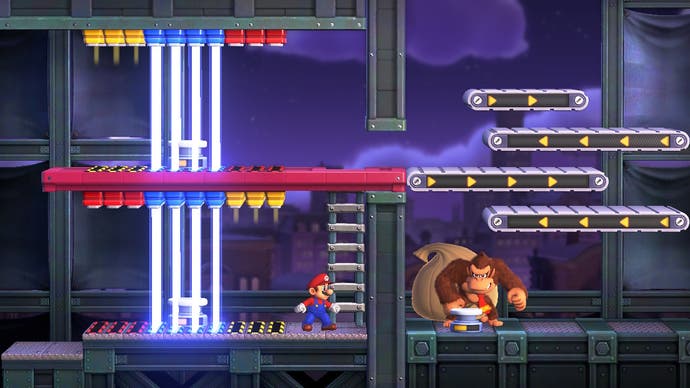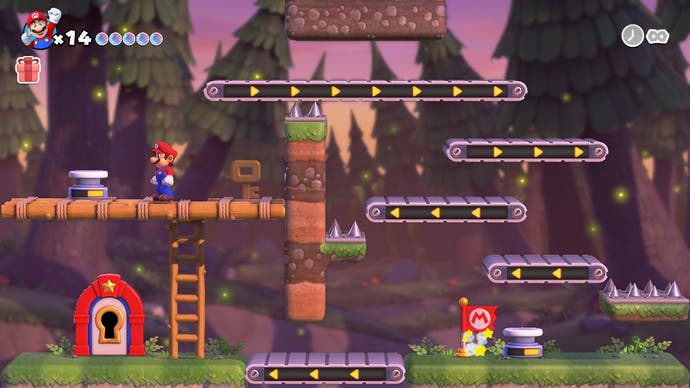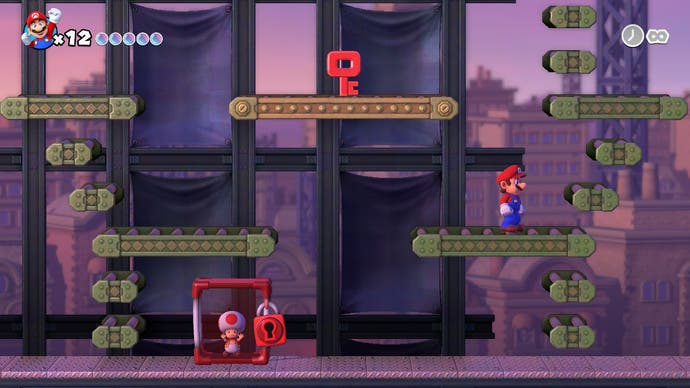The Switch is safely into its Vegas residency era now. So safely, in fact, that with the greatest hits out of the way it's offering up some deep cuts and B-sides. I am all for this. Following on from the Super Mario RPG remake, here's Mario vs. Donkey Kong, a gentle reworking of an old Game Boy Advance charmer. It's lovely stuff.
And it's interesting, too. It makes one think. Not just because it's Mario at its most puzzley, with each mini-challenge playing out like the weird equivalent of a Mario Sudoku or some other newspaper brainteaser. It makes me think because it's another reminder of how Mario, of all game series, is sort of a language that players like me have spent the last few decades learning to speak.
As with language, I'm still learning to recognize how much of the grammar I didn't consciously know that I understand, as it were. What I get in a game like this, then, is a series of actions and reactions I am surprised to learn I can anticipate. Ice will cause me to slide, sure. But when precisely did I learn that a certain kind of block will cause me to teleport, while another will vanish if a switch is flipped? Elsewhere, from a truly ancient part of my brain I somehow retained the information that I will climb up faster if I'm holding two ropes, but descend faster if I'm only holding one. This kind of recall? From a man who regularly calls his dog “doghead”, because her precise name cannot be grasped at the moment? (It's Cricket – I just checked.)
Mario vs. Donkey Kong – Overview trailer (Nintendo Switch)
Fittingly, Mario vs. Donkey Kong is a game that I played upon release on the GBA but have almost completely forgotten. I have it in the attic somewhere, but not in the brain. It doesn't matter. Aside from a few points, which we will get to, this is a straight remake, although, in my case, a remake that might as well be an entirely new game.
It's simple stuff on the surface, and then becomes progressively more riddled with playful complications. Moving across a range of themed worlds, Mario must rescue little clockwork versions of himself, one per level. These levels are split in half: in the first half you need to navigate a 2D platforming gauntlet, collect a key, and bring it back to a locked door. In the second, you need to navigate a 2D platforming gauntlet and rescue that little clockwork Mario. After doing a world's-worth of these things, you have two special boss levels. In the first, you lead all your clockwork Marios across the level to a toy chest. In the second, you fight Donkey Kong, and any of the clockwork Marios you successfully rescued by leading them to the chest count as your health points.


This is a perfect template for what Nintendo does really well: throw in complications and ideas that stretch the boundaries of everything you've learned. In the early levels, just getting the key to the lock is sometimes tricky enough, for example, because when you're holding the key you can't do more complex jumps or climb ladders. But then the game throws in enemies with tails you can grab to cross gaps – if you can get them in the right place – and other enemies who you might be able to stand on to cross spike pits and all that jazz. Put the key down and you get a timer clicking away that gives you fifteen seconds to pick it up again before it disappears. Is that fifteen seconds enough time to open a path to the door, or two at least get you closer to the door?
Add lasers, ice, platforms that move, switches that change the direction of moving platforms, different colored blocks that pop in and out of existence when you press a button. Add a lovely spin on the Mario jump that gives you three possible heights. Add walking on your hands!



There's a lovely sense of ebb and flow to the challenge as you grasp all this stuff, too. Getting the key to the lock is often quietly taxing (by the game's gentle standards, at least), so the next part of the level, where you only have to reach the clockwork Mario, often feels like a bit of a reward. Similarly, leading your clockwork Marios to their toybox – across the same map, but often using a different path, because they can't climb ladders or make certain jumps – is a surprisingly anxious business. Compared to that, the Donkey Kong boss fight that follows is pure catharsis.
Onto the new stuff. So the original game's six worlds have now become eight, with the inclusion of Merry Mini-Land and Slippery Summit. The first of these introduces gust platforms that must be switched on and off, as well as a spring that can be carried around for big jumps, and – I think – it introduces the teleportation block. Slippery Summit offers ice and sliding, two ideas which are used to turn levels into little automated machines that one must pick through with care and imagination. Both of these new additions are great, but for me it's all about Twilight City, a later world that was present in the original. Lasers, girders, robots and evening jazz on the soundtrack. Oh, Nintendo.
What else is new? The graphics have been updated, which strikes me as a little bit of a shame actually. The one thing I can definitely remember about the original game is that it used these sheeny pre-rendered faux-3D models, which looked gloriously odd on the GBA screen, and that's all been replaced with standard Modern Mario. It's fine, but it reminds me of those TikToks that inform us that technology used to look like those lavishly bizarre MiniDisc players, and now looks like a quiet, tasteful Samsung Galaxy. For shame.
Elsewhere, there's a new casual mode, which drops out the time limits, gives you five hits before you expire, and adds checkpoint flags. And there's couch-based co-op for two players, which is surprisingly great. Toad joins Mario, but there are also now two keys you need to get to open the door. And with the game's snug 2D worlds and that classic Mario play of cause and effect, it can be great for creating quite bitter arguments. If you're going to try and collect the three optional presents strung across each level, it's even more deadly.
Get to the end of the short campaign and you realize it isn't short at all, with time attacks and plus levels and expert levels unrolling before you It's a lovely package, and another pleasant stop on the Switch's protracted farewell. The more I played, the more I found myself collecting fragments of memories of the original GBA which I thought I had lost. Familiarity, then, and forgotten pleasures: isn't that what a Vegas residency should be all about?
#Mario #Donkey #Kong #review #Switch39s #protracted #farewell #continues #style